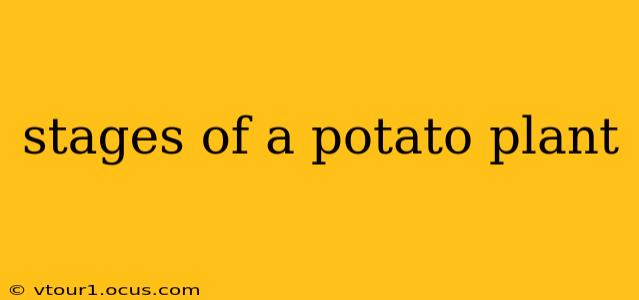Potatoes, a staple food worldwide, undergo a fascinating life cycle from a humble seed potato to the starchy tubers we enjoy. Understanding the stages of a potato plant's growth is crucial for successful cultivation, whether you're a seasoned farmer or a home gardener. This comprehensive guide will walk you through each stage, answering common questions along the way.
Stage 1: Sprouting (Germination)
The potato's journey begins not from a seed, but from a seed potato – a whole potato cut into pieces, each containing at least one "eye" (bud). These eyes contain the plant's potential. When planted in suitable conditions (typically moist soil and warm temperatures), the eyes begin to sprout. This sprouting, or germination, is the first critical stage. Sufficient moisture and warmth are essential for successful germination.
Stage 2: Emergence and Early Growth
Once the sprouts have developed sufficiently, they emerge from the soil. These initial shoots are delicate and require consistent moisture and protection from frost. During this early growth phase, the plant focuses on establishing its root system, which will anchor it in the ground and absorb essential nutrients and water.
What are the first signs of a potato plant sprouting?
The first signs of sprouting are small, white shoots emerging from the "eyes" of the seed potato. These shoots will gradually lengthen and turn green as they reach the surface. The speed of emergence depends on soil temperature and moisture levels.
Stage 3: Vegetative Growth
This is the period of rapid growth where the potato plant focuses on developing its leafy stems and foliage. The plant's leaves are crucial for photosynthesis, converting sunlight into energy for growth. Healthy foliage indicates a thriving plant and sets the stage for tuber development.
Stage 4: Flowering and Tubering
Once the plant has established a strong vegetative structure, it starts to flower. While the flowers are visually appealing, they're not essential for potato production. It's during this flowering stage that the crucial process of tubering begins underground. The plant diverts energy from leaf growth into developing the tubers, which are the underground stems we harvest.
How long does it take for potato plants to flower?
The time it takes for a potato plant to flower varies depending on the variety, climate, and growing conditions. Generally, it can range from 6 to 10 weeks after planting.
Stage 5: Tuber Bulking
After flowering, the tubers continue to swell and increase in size, accumulating starch reserves. This is the crucial period for achieving a large and high-yield harvest. Consistent moisture, nutrients, and sunlight are vital for maximizing tuber size during this stage.
Stage 6: Maturation and Harvesting
As the plant matures, its leaves begin to yellow and die back. This signifies that the tubers have reached their full size and are ready for harvesting. Premature harvesting will result in small, immature potatoes, while leaving them in the ground too long can lead to damage or rotting. Careful consideration of the variety and climate is essential for determining the optimal harvest time.
When is the best time to harvest potatoes?
The best time to harvest potatoes is typically when the foliage has died back and the soil is dry enough to easily dig. This usually occurs 70 to 100 days after planting, depending on the variety.
Conclusion
Understanding the different stages of a potato plant's life cycle empowers you to optimize your cultivation efforts, resulting in a bountiful harvest of delicious potatoes. By paying attention to the specific needs of the plant at each stage, from sprouting to harvesting, you can significantly improve your success in growing these versatile and essential crops.
